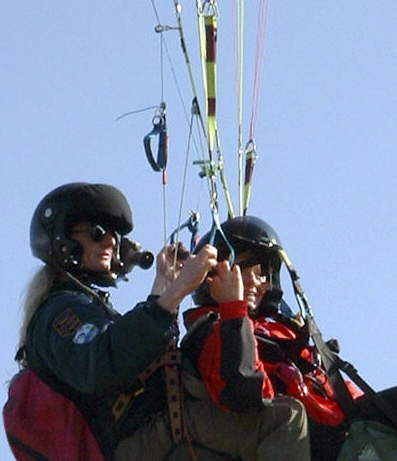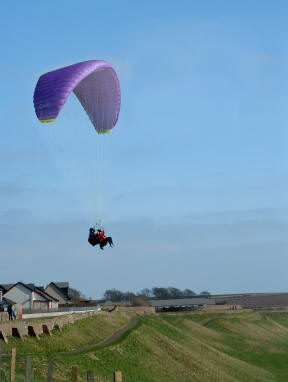|
|
|||||||||||||
 |
|||||||||||||
|
|
||||||||||||||||
|
Having spent most of my life coming up with new ways to do things and modifying everything in sight, and after six years and over 1,500 hours air time flying paragliders and teaching PG pilots, it only took about five minutes into my first tandem flight with a student to see a number of problems and dangers inherent in passing the controls to my passenger should they wish to try controlling the the paraglider. From an instructor’s viewpoint, there are a number of advantages of being able to allow your student full control of the glider within limits. Not only can you teach the student in a “real world” environment, letting them feel what effect their input has on the ship above them, but also being there with your student provides a situation where instruction becomes a real-time discussion, instead of a the one way, delayed dictation input of a radio. And from a safety standpoint, the advantages of having a instructor ready at the controls if things were to get dicey should be obvious. Simply passing toggles to your passenger without the modifications that I outline here simply isn’t practical for a couple reasons... and yet this is what is common in the rest of the world, the resultant position for the student is unnatural and strained even with the Dual Control the position is not perfect. The Dual Control is the only way for the instructor to regain control of the glider if he need’s to. The solution was so obvious it was difficult to understand why my idea hadn't been produced already. |
|
|
||||||||||||||||||||
|
I spent less than 30 minutes working with on one of the industrial sewing machine the club owns (you can ask your local shoe repair or sail loft), a few pulleys, and some extra line and brake handles to produce the first fully working version. The next day with good weather the dual control system was ready for its first test flight! Everything worked well right from the start. The only minor change involved moving the new pulley down another two inches to the bottom of the 'C' riser that evening (I fly a Nova *X-LARGE* 37 which has three risers). With a lower position for the pulley the height is nearer to that on a solo glider for the student giving an improved arm/hand position. Total design, build and modification time was under an hour and cost approx $30 in bits. Of the 3,500+ hours airtime so far, over 300 hours have been with students on my dual-control gliders. During these tandem flights, almost 90% of the time the student was in control including on landing and also sometimes on ‘Take Off’, with me ready to override or assist at any time. This system allows for both automatic (on over braking) and manual disconnection by the pilot in charge all within a fraction of a second! |
|
|
||||||||||||||||||||||||||||
|
|
||||||||||||||||||||
|
For specific, detailed advice on Dual Control Tandem Training in your country and other methods of improving paragliding training feel free to contact me on UK mobile 0783-11-22-480 |
| [Home] [Dual Control] [Min Sink] [Control Options] [Lazy & Efficient] [Speed Systems] |


